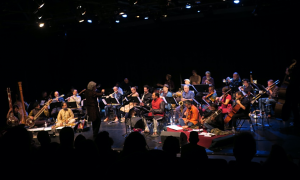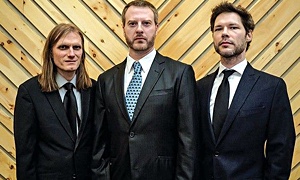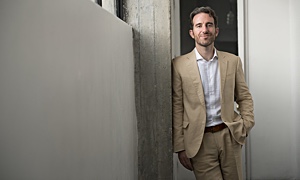Home » Jazz Articles » Live From Philadelphia » The Kimmel Center's Dobson Organ: The Inside Story
The Kimmel Center's Dobson Organ: The Inside Story
What the Kimmel hopes to get from its chosen maker... is a state of the art instrument that will project a stunning variety of sounds with a magnificent range of dynamics, from whispering pianissimos to hall-vibrating triple fortes.

WIDTH=300 HEIGHT=445>Imagine, then, the care that a concert hall will take when they select their organ and organ builder. I found out in no uncertain terms when I attended the July 25, 2005 media event to publicize the new Dobson organ (still under construction) at the Kimmel Center for the Performing Arts in Philadelphia. More than six years ago, they conducted a world-wide search for their organ and organ maker. When the project is completed, it will cost no less than $6 million from start to finish. On May 11, 2006 the organ will debut in a concert with the Philadelphia Orchestra with their Musical Director, Christoph Eschenbach, conducting several works for organ and orchestra. This will be followed by a week of organ recitals.
Why, you ask, should this be of interest to jazz fans and musicians? Well, the hope expressed by Mervon Mehta, the Kimmel's Vice-President in charge of Programming, is that the instrument will ultimately be used in their Mellon Jazz Series, with one proviso: that a musician comes forth who is gutsy, talented, and resilient enough to use it. Since most of the time, jazz organists use transportable electronic instruments, they will need to adapt to the special characteristics of this classical console and the massive sound of the pipes. Joel Kuznik, a New York- based classical organist and journalist, assured me that this is indeed possible. Mr. Mehta, who has vigorously promoted jazz at the Kimmel, deeply hopes it will come about, although he is still discussing the possibility with the jazz musicians, who have expressed both doubts and great expectations about the enterprise. My prediction is that, within a couple of years, this will happen — the time has come!
The operating principle of an organ is simple. Air is blown, not unlike a flute, over a slit in a pipe that has been cut to a specified length, producing a vibration, a sound of a certain pitch. But to get all the different effects, a massive array of pipes must represent a multitude of different notes, timbres, and loudness. The air must be sucked in (in this case by a 27 horsepower motor!), contained, and blown into the pipes at specified rates. All this must be connected to a console with several keyboards, pedals, and stops which the organist uses to perform some of the most elaborate keyboard music ever written, or — in the case of jazz — improvised. The result is a gargantuan instrument, the mechanisms of which are hidden from view. A full-sized organ, such as the one at the Kimmel, may be the only musical instrument other than a church belfry into which one can walk! And it may — and usually does — take several years to construct.
When you go inside the Dobson organ, you find yourself in a little alcove, from which you can peek out at Verizon Hall, an auditorium designed in the curvilinear shape of a cello, in beautiful reddish brown woods and myriad red upholstered seats. From this catbird vantage point, the exquisite aesthetics of the hall are breathtaking. Within the alcove, you are surrounded by an array of pipes arranged in meticulous order. You can also see the mechanisms and electronic relays that activate the pipes. This is one of the few organs with both electric and mechanical triggering, which will allow it to be operated from a console beneath the organ behind the stage, and a moveable console on the stage itself. Michael Stairs, the official organist of the Philadelphia Orchestra, insisted on a stage console so he can look directly at the conductor. (For the fixed console, the organist sees the stage via a TV monitor.) The fixed console is operated mechanically, while the stage console is connected electronically. Mr. Dobson pointed out that the dual mechanism is difficult to achieve, and he hopes the one at the Kimmel will be the finest of its kind.

WIDTH=300 HEIGHT=394>Why all this time, money, and effort to construct a single musical instrument? What the Kimmel hopes to get from its chosen maker, Mr. Lynn Dobson, along with his extraordinary knowledge and craftsmanship, his crew, and his worldwide purchase of organ parts, is a state of the art instrument that will project a stunning variety of sounds with a magnificent range of dynamics, from whispering pianissimos to hall-vibrating triple fortes. In addition, it will be incredibly and instantly responsive to the musician who performs on it. And, finally, it will have advanced computer technology that allows it to be pre-programmed in a variety of ways and to "record the performance like a piano roll for later playback. In other words, it will bring an entire new dimension of sound and music-making to the concert hall. In addition to orchestral, solo, and small group performances, the Kimmel is planning (just for the fun of it, one supposes) a series of silent film showings and puppet shows where the background music will be performed on the new organ. The instrument, still in the installation process, is to be debuted in May of 2006, after the delivery and fitting of another round of pipes that will be delivered from Dobson's factory in Lake City, Iowa to Philadelphia in a "semi tractor trailer. The word "huge summarizes everything about this project.
Just in case you think that jazz organ is the province of a few select keyboardists like Jimmy Smith and Joey De Francesco, I'll wrap up this article with a list of the better known jazz organists from the on-line encyclopedia Wikipedia. The Dobson Organ is not an instrument one can stick in the back of a van, but there are plenty of keyboardists, past and present, who might tackle its formidable pipes.
They include: Adam Scone; Alberto Marsico; Amina Claudine Myers; Arno Krijger; Baby Face Willette; Barbara Dennerlein; Big John Patton; Bill Doggett; Bill Heid; Brian Auger; Bruce Katz; Carla Bley; Carlo de Wijs; Charles Earland; Charles Kynard; Daisuke Kawai; Dan Wall; Daniel Thouin; Denis Keldie; Dieter Reith; Dirk Van der Linden; Doc Bagby; Don Paterson; Don Pullen; Mac "Dr. John" Rebbenack; Eddie Bacchus; Eddie Landsberg; Eddy Louiss; Emmanuel Bex; Ethel Smith; Fats Waller; Freddie Roach; Gene Ludwig; Georgie Fame; Glen Hardman; Greg Hatza; Herbert Noord; Ingfried Hoffmann; Jack McDuff; Jackie Davis; Jackie Ivory; James Taylor; Jasper Van't Hof; Jeff Palmer; Jimmy McGriff; Jimmy Smith; Joe Bucci; Joe Zawinul; Joey DeFrancesco; John Medeski; Johnny "Hammond" Smith; Jon Hammond; Karen Mantler; Keith Jarrett; Ken Clark; Kjeld Lauritsen; Kjell Oehmann; Klaus Wunderlich; Larry Goldings; Larry Young; Lonnie Gasperini; Lonnie Smith; Lou Bennett; Lucky Peterson; Matthias Baetzel; Mauri Sanchis; Melvin Rhyne; Merl Saunders; Micky Tucker; Midori Ono; Mike Carr; Mike LeDonne; Milt Buckner; Paolo Negri; Paul Flush; Paul Wagnberg; Pierre Swaerd; Reuben Wilson; Rhoda Scott; Richard Groove Holmes; Rick Allen; Ron Levy; Sam Yahel; Shirley Scott; Sir Charles Thompson; Stefan Patry; TC Pfeiler; Tim Neal; Tom Coster; Tony Monaco; Trudy Pitts; Walter Wanderley; Wayne Horvitz; Wild Bill Davis; Wojciech Karolak.
To name but a few!!! Jazz organ is here to stay. And so is the Dobson organ at the Kimmel Center. May the two meet in musical harmony!
Visit Kimmel Center for the Performing Arts and Dobson Organ on the web.
< Previous
Outre Mer
Next >
When the Sun Comes Out
Comments
Tags
For the Love of Jazz
 All About Jazz has been a pillar of jazz since 1995, championing it as an art form and, more importantly, supporting the musicians who create it. Our enduring commitment has made "AAJ" one of the most culturally important websites of its kind, read by hundreds of thousands of fans, musicians and industry figures every month.
All About Jazz has been a pillar of jazz since 1995, championing it as an art form and, more importantly, supporting the musicians who create it. Our enduring commitment has made "AAJ" one of the most culturally important websites of its kind, read by hundreds of thousands of fans, musicians and industry figures every month.





















